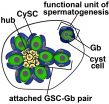(Press-News.org) The human genome encodes roughly 20,000 genes, only a few thousand more than fruit flies. The complexity of the human body, therefore, comes from far more than just the sequence of nucleotides that comprise our DNA, it arises from modifications that occur at the level of gene, RNA and protein.
In a new study, researchers from the University of Pennsylvania School of Veterinary Medicine show how one of these modifications, which occurs after RNA is translated into proteins, has the power to greatly influence the function of an enzyme called PRPS2, which is required for human life and can become hyperactive in cancer.
This type of protein modification, known as arginylation because it attaches an arginine molecule to the protein, has only recently been characterized, but likely plays an important role in regulating not only PRPS2, but a plethora of other proteins that are necessary for life.
"This is the first time anyone has demonstrated that arginylation can regulate an enzyme's activity," said Anna Kashina, senior author on the paper and a professor of biochemistry at Penn Vet. "I think mechanisms like this one likely regulate a host of important genes."
The Penn Vet's team findings also hold significance for cancer treatment strategies. The process of arginylation could be a target for intervention, and it's possible that gene therapy modifications to PRPS2 could prevent the uncontrolled cellular expansion seen in metastatic growths.
Kashina led the work along with co-lead authors Fangliang Zhang, formerly of Penn Vet and now at the University of Miami, and Devang M. Patel of the University of Miami. Additional coauthors included Penn Vet's Kristen Colavita and Sougata Saha, who is now at India's Tezpur University; Irina Rodionova, David Scott and Andrei Osterman of Sanford Burnham Medical Research Institute; Brian Buckley and Mikhail Chernov of Roswell Park Cancer Institute and Akhilesh Kumar of the University of Miami.
The research is reported this week in the journal Nature Communications.
Kashina has spent the past several years studying arginylation and has found that it often regulates proteins that are involved in basic, but critical, functions in the cell, and are represented by multiple copies in the genome. They're often referred to as "housekeeping genes." In 2010, she and colleagues published a paper in Science showing that arginylation regulates an actin protein, which is required for cell movement and for maintaining cellular structure.
"People used to assume that the reason for families of identical proteins was because they were so essential that the genome built in some redundancy," Kashina said. "But as people started studying these protein families, they realized that virtually identical family members often have different functions and that they are not actually redundant at all."
The question remained: how can seemingly identical proteins take on different functions?
To find out, Kashina's team examined two members of one such family of highly similar proteins: PRPS1 and PRPS2. Both are involved in the production of new nucleotides, the building blocks of DNA. The researchers had previously learned that PRPS2 is arginylated while PRPS1 is not. The team also knew from prior work that PRPS2 plays a role in cancerous growth, as cancer cells reproduce rapidly and need a constant source of nucleotides in order to keep up a fast rate of growth.
In the current study, the team got further clues that arginylation played a role in the different roles of PRPS1 and PRPS2 when they examined cells in which arginylation had been blocked by making the enzyme that adds arginine, ATE1, inoperative. They found that these cells had problems with making purine nucleotides, the As and Gs of the DNA sequence. The genetically modified cells also made more serine and glycine amino acids than normal cells, a further sign that purine synthesis was impaired. Because both PRPS proteins are involved in purine nucleotide synthesis, they were clear candidates for being subject to regulation by arginylation.
In additional experiments, the researchers found that overall PRPS protein levels were higher in cells in which ATE1 was inactive, and that PRPS2 in particular was nearly three times more active when it was arginylated.
Many post-translation protein modifications target proteins to be broken down and destroyed. When the team introduced arginylated forms of PRPS1 and PRPS2 into cells, they found that PRPS1 was unstable and quickly degraded, while PRPS2 survived arginylation.
Although PRPS1 and PRPS2 are highly identical when it comes to their amino acid sequences, the researchers surmised their differences in regulation may be attributed in part to slight differences in their nucleotide sequences, which affect how mRNA strands are shaped. The structure of PRPS1 mRNA is likely to slow down the process of translation, the researchers believe, perhaps making that protein vulnerable to degradation once it is arginylated. Because PRPS2 mRNA lacks the same obstructions to translation, it appears able to survive arginylation without being targeted for degradation.
"To me an exciting part of this work is that it seems possible to regulate the protein function just by coding sequence," Kashina said. "We used to believe that coding sequence encodes only the sequence of amino acids but actually it encodes a lot more."
Knowing that PRPS2, which has been implicated in driving cancer, is regulated by arginylation provides a potential "switch" for tuning that activity. And the importance of mRNA structure in how a protein is eventually treated could give another way of targeting PRPS2's activity and turning it down to prevent the uncontrolled growth seen in malignancies.
"If we know that coding sequence affects post-translational modifications, this could become a potential new strategy for gene therapy by making substitutions that don't alter the amino acid sequence of a protein but alter this regulation," Kashina said.
Looking ahead, Kashina hopes to examine the role of arginylation for a number of other housekeeping protein families.
"I believe it's a very global process," she said.
INFORMATION:
The research was supported by grants from the National Institutes of Health and the Mari Lowe Center for Comparative Oncology.
Athens, Ga. - Researchers from the University of Georgia have determined that various freshwater sources in Georgia, such as rivers and lakes, could feature levels of salmonella that pose a risk to humans. The study is featured in the July edition of PLOS One.
Faculty and students from four colleges and five departments at UGA partnered with colleagues from the Centers for Disease Control and Prevention and the Georgia Department of Public Health to establish whether or not strains of salmonella exhibit geographic trends that might help to explain differences in rates ...
DURHAM, N.C. - Children with even mild or passing bouts of depression, anxiety and/or behavioral issues were more inclined to have serious problems that complicated their ability to lead successful lives as adults, according to research from Duke Medicine.
Reporting in the July 15 issue of JAMA Psychiatry, the Duke researchers found that children who had either a diagnosed psychiatric condition or a milder form that didn't meet the full diagnostic criteria were six times more likely than those who had no psychiatric issues to have difficulties in adulthood, including ...
Children with psychiatric problems were more likely to have health, legal, financial and social problems as adults even if their psychiatric disorders did not persist into adulthood and even if they did not meet the full diagnostic criteria for a disorder, according to an article published online by JAMA Psychiatry.
Neuropsychiatric disorders among young people ages 10 to 24 are a leading cause of disease burden globally. Unlike many chronic physical health problems, most psychiatric disorders are first diagnosed in childhood, which allows the disorder to affect a person's ...
PHILADELPHIA - Stem cells are key for the continual renewal of tissues in our bodies. As such, manipulating stem cells also holds much promise for biomedicine if their regenerative capacity can be harnessed. However, understanding how stem cells govern normal tissue renewal is a field still in its infancy.
Researchers at the Perelman School of Medicine at the University of Pennsylvania are making headway in this area by studying stem cells in their natural environment in an organism. Stem cell populations reside in areas called niches deep within different types of organs. ...
States with more restrictive alcohol policies and regulations have lower rates of self-reported drunk driving, according to a new study by researchers at the Boston University schools of public health and medicine and the University of Minnesota School of Public Health.
The research team assigned each state an "alcohol policy score," based on an aggregate of 29 alcohol policies, such as alcohol taxation and the use of sobriety checkpoints. Each 1 percentage point increase in the score was found to be associated with a 1 percent decrease in the likelihood of impaired driving, ...
Final results of the randomized intergroup EORTC, LYSA (Lymphoma Study Association), FIL (Fondazione Italiana Linfomi) H10 trial presented at the 13th International Conference on Malignant Lymphoma in Lugano, Switzerland, on 19 June 2015 show that early FDG-PET ( 2-deoxy-2[F-18]fluoro-D-glucose positron emission tomography) adapted treatment improves the outcome of early FDG-PET-positive patients with stages I/II Hodgkin lymphoma.
Dr. John Raemaekers of the Radboud University Medical Center Nijmegen and the Rijnstate Hospital Arnhem, The Netherlands, and EORTC principal ...
HOUSTON - (July 15, 2015) - Three-dimensional structures of boron nitride might be the right stuff to keep small electronics cool, according to scientists at Rice University.
Rice researchers Rouzbeh Shahsavari and Navid Sakhavand have completed the first theoretical analysis of how 3-D boron nitride might be used as a tunable material to control heat flow in such devices.
Their work appears this month in the American Chemical Society journal Applied Materials and Interfaces.
In its two-dimensional form, hexagonal boron nitride (h-BN), aka white graphene, looks ...
A University of Toronto research team has discovered new details about a key gene involved in ALS, perhaps humanity's most puzzling, intractable disease.
In this fatal disorder with no effective treatment options, scientists (including members of U of T) achieved a major breakthrough in 2011 when they discovered mutations in the gene C9orf72, as the most frequent genetic cause of ALS and frontotemporal dementia. But little was known about how this gene and its related protein worked in the cell.
To solve this problem, Professor Janice Robertson and her team at the ...
Sapphirina, or sea sapphire, has been called "the most beautiful animal you've never seen," and it could be one of the most magical. Some of the tiny, little-known copepods appear to flash in and out of brilliantly colored blue, violet or red existence. Now scientists are figuring out the trick to their hues and their invisibility. The findings appear in the Journal of the American Chemical Society and could inspire the next generation of optical technologies.
Copepods are tiny aquatic crustaceans that live in both fresh and salt water. Some males of the ocean-dwelling ...
Five years ago this week, engineers stopped the Deepwater Horizon (DWH) oil spill -- the largest one in U.S. history, easily displacing the Exxon Valdez spill from the top spot. Now, Chemical & Engineering News (C&EN), the weekly newsmagazine of the American Chemical Society, takes a look at the lessons scientists are learning from these accidents to improve clean-up efforts and, perhaps, prevent spills altogether.
C&EN Senior Editor Jyllian Kemsley explains that although both spills were caused by human error, they each posed unique challenges. When the tanker Exxon ...

